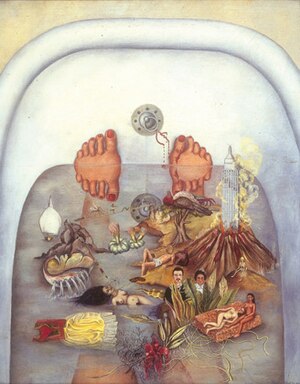POSTCARD IV (SW)
In the ‘Watery Worlds’ chapter, Bridget Moyle and Amelia Loughland argue the need for representations of water that resist human containment and commodification. This is reflected in their concept of the equirium, which creates “arcing and distorted perspectives of place” through depictions of water akin to “hybridised […] rhizomatic passageways” that give light to “relational communities.” However, while Moyle, et al., dismiss baths as yet another example of water being confined, the rhizomatic concept of bathwater can be employed in conjunction with the equirium, as a means of elucidating an eco-skeleton that structures and restrains human experience vis-à-vis the material world. Essentially, bathwater resists anthropocentric control through its ephemeral and liminal nature, resulting in it being neither here nor there and on a perpetual journey of renewal and discovery. This idea is brought to life in twentieth century Mexican artist Frida Kahlo’s 1938 painting What the Water Gave Me (Fig. 2), which masterfully illustrates how the experience of taking a bath allows transient bathwater to influence human vision and perception.
Australian academic Astrida Neimanis’ focus on the “transcorporeal transits” (Neimanis, 2013, p. 25) between watery worlds and the human body, via intra-active exchanges that postulate both human and non-human as “always becoming in webs of mutual implication” (Neimanis, p. 25) can be expanded on in Kahlo’s imagery. For example, in What the Water Gave Me, the bathwater propels an invasive, discombobulating stream-of-consciousness in the human subject through entwined icons of personal, political and cultural (Howland, 2017) suffering inherent in the artwork. The disjunction between the environmental and the commercial is exhibited in Kahlo’s juxtaposition of the Empire State Building against an erupting volcano, whereas her traumatic upbringing versus Mexico’s bloody political history is paralleled by her parents’ portraits and a fleet ship. This bizarre, anxious montage aligns with feminist philosopher Rosi Braidotti’s notion of “political fictions” and “living maps” informed by “oriented perspectives” that conflate both the “local” and “global,” (Neimanis, p. 26) thereby dismantling conventional temporal time to produce new human experiences. Moyle, et al.’s close reading of American modernist poet T.S. Eliot’s 1941 poem The Dry Salvages similarly explores the capacity to exist outside of socially-bound, capitalist-centric human temporality. As a result, by utilising the notion of the equirium in conjunction with the works of Frida Khalo’s What the Water Gave Me, the capacity of marginal, ephemeral natural constructs – such as bathwater – to enact as eco-skeletons and structure, script and restrain human experience, is manifest.
REFERENCES
Neimanis, A. (2013). feminist subjectivity, watered, 103, 23-41.
Howland, R. (2017, January 2). An Interpretation of Frida Kahlo’s “What The Water Gave Me.” Odyssey, Retrieved from https://www.theodysseyonline.com/interpretation-kahlo-water-gave-me
IMAGE LIST

Figure 2
Kahlo, F. (1938). What the Water Gave Me [oil paint]. 91 cm x 70 cm. Collection of Daniel Filipacchi, Paris.
SW.